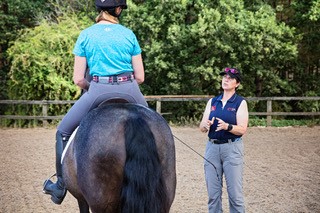Jo is now a Doctor!
“An exploratory investigation into perceptions of risk management in equestrian sports coaching from a practitioner and governing body perspective, leading to the creation of a bowtie mode”.
Jo has been very busy studying for Professional Doctorate in Sport and Exercise (PDSE) at the University of Gloucestershire and this will give you a flavour of what was involved:
The Professional Doctorate has been designed for sport and exercise professionals who are interested in engaging with major projects within or beyond their organisation. This enabled Jo to study, research and respond innovatively to the rapidly changing sports, physical activity and wellbeing environment in the equestrian industry. It’s aimed at professionals who may not have studied for some time but are experts in their area – providing a higher degree programme specifically structured to support change within professional practice. Jo was able to maintain her professional commitments – the programme integrates doctoral level study with continuing professional practice (coaching and training). The University of Gloucester’s aim is to develop leaders who can improve practice within sport and physical activity realms, by addressing local, regional, national and international concerns, and who have the ability to build evidence bases that inform policy and practice development which Jo’s study achieved.
As part of the submission process, Jo produced an Executive Report (which is available on request), that was disseminated to NGB’s and involved parties highlighting the findings of the research to create the opportunity of organisational change in their professional practice via the introduction of a Bowtie risk model.

A taste of Jo's research project
An exploratory investigation into perceptions of risk management in
equestrian sports coaching from a practitioner and governing body perspective,
leading to the creation of a bowtie model.
Abstract
Equestrianism has become increasingly popular, and participation levels are high,
with 1.8 million people riding on a regular basis in the UK alone. It is recognised as
a high-risk activity, and compliance with health and safety legislation is required for
the safety of all those involved. Currently, the evaluation of risk in equestrianism
focuses on the assessment of individual events rather than the effectiveness of the
overlying safety management protocols. Whilst basic risk assessment occurs within
equestrian coaching, broader evaluation of overlying safety management remains
limited throughout this sector. This work has identified relevant hazards, evaluated
the associated risks, and suggested controls and mitigation strategies to support
equestrian coaches in adopting and improving safety management systems. Three
studies were undertaken; the first used semi-structured interviews with national
equestrian governing bodies (NGB) (N=3) and their allied insurance brokers (N=3),
with questions exploring organisational policy; for instance, “What are your minimal
requirements for your NGB to accredit coaches?”; “When would you expect a risk
assessment to be done?” and “How would this be evidenced?” A thematic analysis
identified emergent themes in the organisational roles and responsibilities (process,
satisfaction with current practice, evaluation of practice, responsibilities, and review)
and the coaches’ role (employment status, coaching practice, and coaching
effectiveness). The second study selected NGB coaches (N=114) through the NGBs’
own databases, using a mixed methods survey distributed online, to evaluate
perspectives of hazards and risk management in equestrian coaching. Frequency
analysis, thematic analysis, and tests of difference and correlation were utilised to
evaluate the perspective. Key results included coach training needs, reflection on
practice, risk management and awareness, insurance, and templating of evidence.
The third study was formed by means of a working party that focused on coach
training and support in managing and evidencing their coaching practice. Purposive
sampling (N=5) was used with an inductive approach to identify emergent themes in
risk management. The interview analysis produced two key discussion points: the
need for risk management training and the desire for a coaching tool/system to
evidence coaching practice. Assessing the types of risk management models that
would support organisational management within this context led to the utilisation of
a bowtie as an illustrative model of these issues. An executive report of these studies
was produced as an industry document for dissemination to the various NGBs.
Based on the results of the studies, four recommendations were made to industry
with regard to the dissemination of results via the NGBs, British Equestrian
Federation (BEF) and the wider audience, including the International Federation for
Equestrian Sports (FEI).



